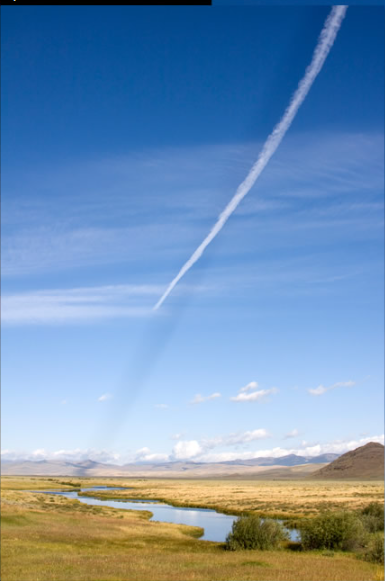Montana Contrail Shadow
Montana Contrail Shadow: A Fascinating Atmospheric Phenomenon
Contrails, short for condensation trails, are a common sight in the skies. These white streaks left behind by aircraft are composed of water droplets and ice crystals that form in the wake of jet engines. While contrails themselves are intriguing, there is a particular phenomenon associated with them that adds an extra layer of fascination - the Montana Contrail Shadow.
The Montana Contrail Shadow is an atmospheric optical phenomenon captured by photographer James Perdue at Culver Pond in Red Rock Lakes National Wildlife Refuge. The image shows a high contrail casting a shadow deep into the atmosphere. What makes this shadow unique is its three-dimensional nature, unlike the typically two-dimensional contrail shadows cast onto lower cloud or haze layers.
Contrail shadows are formed when sunlight is blocked by the contrail itself, creating a shadowy area in the sky. However, most contrail shadows appear as flat, dark streaks on the cloud or haze layer below. In the case of the Montana Contrail Shadow, the shadow extends vertically, creating a distinct volume of dark air.
The formation of the Montana Contrail Shadow can be attributed to several factors. Firstly, the altitude at which the contrail forms plays a crucial role. The higher the contrail, the more likely it is to cast a three-dimensional shadow. Additionally, atmospheric conditions such as humidity and temperature influence the formation of ice crystals within the contrail, further enhancing its shadow-casting capabilities.
It's important to note that while contrail shadows may appear mysterious and intriguing, they are purely optical phenomena with no direct impact on weather or climate. However, studying these phenomena can provide valuable insights into atmospheric conditions and help improve our understanding of cloud formation and behavior.
Contrail shadows, including the Montana Contrail Shadow, serve as a reminder of the complex interactions between sunlight, atmospheric particles, and human activity. As aircraft continue to traverse the skies, leaving contrails in their wake, these shadows offer a visual representation of the intricate interplay between nature and technology.
In conclusion, the Montana Contrail Shadow is a captivating atmospheric phenomenon captured in an image by James Perdue. Its three-dimensional nature sets it apart from typical contrail shadows, adding an extra layer of intrigue. Understanding the factors that contribute to the formation of these shadows can enhance our knowledge of atmospheric dynamics and provide valuable insights into the complex workings of our atmosphere. So, the next time you gaze up at the sky and spot a contrail, take a moment to appreciate the potential for a mesmerizing shadow lurking just beneath it.

Montana Contrail Shadow imaged by James Perdue at Culver Pond in Red Rock Lakes National Wildlife Refuge. Image �James Perdue, shown with permission.
The high contrail comprised of water droplets and possibly ice crystals has cast a shadow deep down into the atmosphere. The shadow is a 3D volume of dark air. In contrast, many contrail shadows cast onto lower cloud or haze layers are 2D.
More contrails below...
Note: this article has been automatically converted from the old site and may not appear as intended. You can find the original article here.
Reference Atmospheric Optics
If you use any of the definitions, information, or data presented on Atmospheric Optics, please copy the link or reference below to properly credit us as the reference source. Thank you!
-
<a href="https://atoptics.co.uk/blog/montana-contrail-shadow/">Montana Contrail Shadow</a>
-
"Montana Contrail Shadow". Atmospheric Optics. Accessed on April 20, 2024. https://atoptics.co.uk/blog/montana-contrail-shadow/.
-
"Montana Contrail Shadow". Atmospheric Optics, https://atoptics.co.uk/blog/montana-contrail-shadow/. Accessed 20 April, 2024
-
Montana Contrail Shadow. Atmospheric Optics. Retrieved from https://atoptics.co.uk/blog/montana-contrail-shadow/.